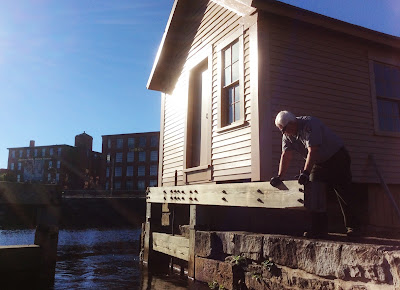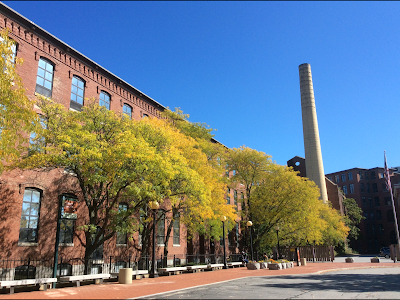In October 2015 I took two boat rides offered by the Lowell National Historical Park for a small fee. Both left from the Swamp Locks. The first trip was to Francis Gate Locks and the second was to the Lower Locks.
Nice cruise down the Pawtucket Canal.
Approching the Francis Gate Locks.
After going under Pawtucket St., we ended up on the Merrimack River. I must say I was very surprised and a little nervous. Now that the bridge is fixed, maybe they'll have the tours next year.
Heading back to Swamp Locks.
The second trip was in the opposite direction, we went to the Lower Locks, near Central St. and the Middlesex Community College.
The boat has left left the locks and travels under the walkway below.
Going under Central Street.
I know we got off, but I think we took a trolley ride back. (The below pictures were the same date and in the right time frame.)
"Much of Lowell's canal system was designed in 1825. However, one especially important component was not implemented until 1848 - the Northern Canal. To this day, the Northern Canal remains one of the city's engineering marvels.
This 100' wide, 20' deep, 4,400' long canal feeds water into the city that is used in the mills for power. In the 1840s, James B. Francis - chief engineer of the canal system – determined that an entirely new canal (unlike any other in the city) was needed to keep mills running on time, especially during the dry seasons. To make the Northern Canal fit with the rest of the canal system, Francis cleverly reversed the flow of the Western Canal. Workers then built an underground tunnel across the city to deliver excess water to factories in need of additional energy, wasting as little water as possible. The Northern Canal nearly doubled the water flowing to Lowell’s canals once it was opened in 1848; this meant double the power for producing cloth and increasing profit.
Lowell's Irish community comprised much of the workforce. They removed dirt and stone using the power of horses, oxen, and of course, their own strength. Between heavy loads and the use of explosives on stubborn stone, the work was difficult and dangerous. Injury rates were very high, even compared to the construction of Lowell's mills."



























